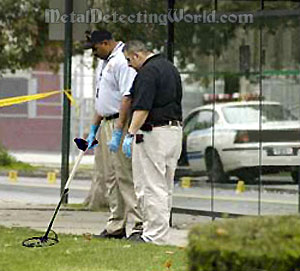Metal Detectors for Police
Compare Reviews, Ratings, Features, Specifications, Prices and Images of Land Metal Detectors Used by Police Crime Scene Units
Created by Sergei UpstateNY, last time modified:
Two types of modern metal detectors are widely used by the police: detectors of the first type are used by crime scene investigators to find ALL metallic evidence, and devices of the second type are used by patrol officers for safety purposes.

Helpful Information on MD's for Police:
Sometimes I receive e-mails from police officers asking for advice on what type of metal detectors could be the best for finding crime evidence. Basically they ask me the same question: "What metal detector would be easy to operate and not too expensive just as long as it gets the job done?" This inspired me to create a list of metal detectors in the low price range, between $200 and $699, that provide maximum performance with minimum setup. The list is split into five Price ranges so that one can choose a detector that is affordable for the Police Department's budget. Each price range includes a list of those key-features that are available on detectors in that category. The number of key-features increases in each price range consecutively.
The most common metal detecting tasks performed by crime scene units, like locating brass shell casings lying in grassy areas, do not require super advanced metal detectors. Therefore, my list of metal detectors for police consists mainly of Turn-On-and-Go metal detectors which are efficient enough to find surface and shallow targets. Such detectors allow an operator to avoid spending unnecessary extra time for adjusting the metal detector to the present ground conditions.
Searching for deliberately buried metallic evidence (e.g. crime weapons, ammunition, etc.) may require the use of more advanced mid-range metal detectors, depending of the strength of mineralization in the ground. In any case, the police metal detector should have a lightweight (below 2.5 lbs) and durable construction consisting of a 3-piece stem that breaks down into a compact protective case for portability.
The following key features are required for a metal detector used to investigate a crime scene:
- Automatic Ground Balance/Automatic Ground Tracking - a mode of operation in which the detector automatically adjusts itself to reduce or eliminate interference that ground mineralization has on metal targets and on detector performance. This mode allows an operator to concentrate on target signals and to avoid re-adjustment of the metal detector when ground conditions change during the search.
- Full Range Notch Discrimination - this feature allows the operator to manually "notch-out" (reject) or "notch-in" (accept) a specific range of metallic items. On the today's market, there are several state-of-the-art metal detectors (Minelab FBS metal detectors) that feature a more advanced Dual Coordinate Discrimination function. This function allows the operator to accept only one particular type of objects. For example, the detector will locate only 9mm brass casings without "picking up" other metallic objects, including bottle cups, pull-tabs, foil, coins, etc., present at the trashy crime scene. However, such detectors might be too expensive for the police budget.
- adjustable Sensitivity allows to reduce sensitivity to small objects in favor of large ones if necessary, as well as to increase sensitivity (detection depth) necessary to detect small targets buried deep.
- Pinpoint mode - this mode helps the operator precisely locate and carefully recover the detected objects. Pinpoint mode is temporarily actuated by pressing and holding a special button on the control panel, or by pulling a trigger switch positioned in front of the operator's hand.
- Liquid Crystal Display (LCD) shows both numerical Target ID and corresponding target icons for visual reference. Normally, target icons or probable Target-ID zones are displayed at the top of the LCD, and represent the signal ranges (categories) produced by various coins and types of metal objects. The classification of the detected objects is usually represented by the following displayed categories: 'Iron', 'Foil', 'Nickel', 'Tab', 'Zink', 'Dime', 'Quarter', etc. The LCD must feature a backlight since crime scene investigations often occur in dim light conditions or at night.
- Waterproof/Submersible Search Coil - such a coil's design allows for target detection in shallow waters (the control box cannot be submerged). Nowadays, all modern metal detectors are equipped with submersible search coils. As for the coil's size, a stock searchcoil (standard coil) that comes with the metal detector is sufficient for finding surface and shallow metal objects. To find deeply buried objects of medium to large sizes, a larger search coil is required.
Most of the police metal detecting tasks can be carried out with cheap metal detectors, even with simple Junior Metal Detectors, but with such devices, it will likely take a crime unit specialist much longer time to accomplish his/her work. The advanced metal detectors enable the specialist to conduct a faster and more accurate location of all targets sought, thus allowing him/her to reduce metal detecting time considerably.
NOTE: On the market, there have been two metal detectors specifically developed for police crime scene investigations and metallic evidence recovery - Garrett CSI Pro and Nokta 109 Deep Pro; however, all metal detectors in a list below can very well serve the purpose and are worth of one's consideration.
What this section is about
Listed in a table below are metal detectors suitable for police work. Each listing may or may not have Reviews and Ratings from real users, but it certainly includes metal detectors' Features, Specifications, Prices, and Images - all necessary information needed for comparison with other machines. Also listed here are the Hand Held metal detectors that effectively target all ferrous, non-ferrous and stainless steel weapons, contraband and other metallic objects which can be secreted on individuals.
Please do not hesitate to contribute by leaving a review if you have already used any detector listed here. Your opinion would be valuable to many specialists!
If you would like to visit any particular metal detector manufacturer's website, you can find its link on my link-directory page:
Websites of All Manufacturers of Metal Detectors Worldwide
MY ADVICE: If you do not find the manufacturer's name on that page, it means that I could not find any reliable information on that manufacturer and its products, or the manufacturer is known for producing either gimmicks based on outdated technology or feeble semblances of reputable metal detectors, or its metal detectors are poorly built from cheap materials in Southeast Asia or Eastern Europe. Or the manufacturer simply ceased production. If you are still in doubt, try to do your own research, but you should definitely check the well known, tested, proven and trusted brands first!
Police Metal Detectors FAQ:
Yes, police use metal detectors, even in small police departments with modest budgets, and the most commonly used two classes of metal detectors are: 1) hand-held devices called 'magic wands' (listed on this page) for personal safety and security, and 2) conventional hobby detectors for investigating crime scenes. Most crime scene units are equipped with modern hobby detectors which often serve as indispensible tools when it comes to effectively investigating a crime scene and collecting metallic evidence such as brass casings and fired bullets embedded into trees, wooden structures or the ground. Other evidence objects that may be overlooked or harm the investigator range from very small items like hypodermic needles invisible in the grass to large hidden objects like semi-automatic rifles or shotguns buried in the ground. Used by either a trained and qualified investigator or an experienced volunteer, the metal detector will not miss a single evidence piece present at the crime scene. A less widely used type of hobby metal detectors is the underwater detector used by coastal police departments.
Police departments have many reasons to have metal detectors at hand so that they can be used every time the situation calls for it. The main reasons are: 1) the use of a metal detector ensures that all metallic evidence is gathered at the crime scene (it is often difficult to locate small evidence pieces on visual inspection), 2) the metal detector significantly reduces the man-hours and efforts required to locate and collect the evidence, e.g., when searching for hidden weapons in a house, an investigator can program the metal detector not to indicate electrical wires and nails/screws in walls or floors, and thus saves significant time, 3) at shooting crime scenes, metal detectors locate brass casings and spent bullets which can then be easily traced and matched up to specific guns using cutting-edge forensic analysis; thus, helping solve crimes lightning fast or when other means fail, and 4) in outdoors, metal detectors reduce or even eliminate the disturbance of crime scenes. A hand worn metal detector (also called 'glove metal detector') or a hand held metal detector (also called 'magic wand' and 'body metal detector') is normally used by patrol officers to find metallic threats concealed on people. It is especially important to carry out a non-invasive search of an arrested suspect for metal items such as a concealed weapon, a mobile phone, small pieces of metal foil which may contain drugs, a razor blade or cuff key in the suspect's mouth, and objects as small as SIM cards, prior to taking the handcuffs off in the department lockup area.
A metal detector suitable for crime scene investigation should be easy to operate and not too expensive just as long as it gets the job done. In terms of mechanicals, such a detector should be lightweight (below 2.5 lbs) and have a durable 3-piece stem to fit into a compact case for easy portability. This detector should be a 'Turn-On-and-Go' type so that an operator does not have to spend unnecessary extra time adjusting the machine to the present search conditions. Considering the most common metal detecting tasks performed by crime scene investigators, the detector must be efficient enough to find surface and shallow metal objects, and this task does not require the use of advanced features and modes usually associated with expensive high-end machines. A police metal detector should include at least the following key features: 1) Automatic Ground Balance/Ground Tracking (a mode of operation in which the detector's circuitry automatically adjusts to the ground mineralizationn which can otherwise generate many false positive signals), 2) Discrimination with a Notch Discrimination option (this allows the operator to manually reject or accept a specific range of metallic objects), 3) adjustable Sensitivity which allows to reduce sensitivity to small objects in favor of large ones if necessary, and 4) Pinpoint - this aids in pinpointing the exact location of objects detected. And finally, the detector must have a large Liquid Crystal Display (LCD), preferably backlit (for night operations), which shows both numerical Target ID and corresponding target icons for visual reference, such as 'Iron', 'Foil', 'Nickel', 'Tab', 'Zink', 'Dime', and 'Quarter'.
